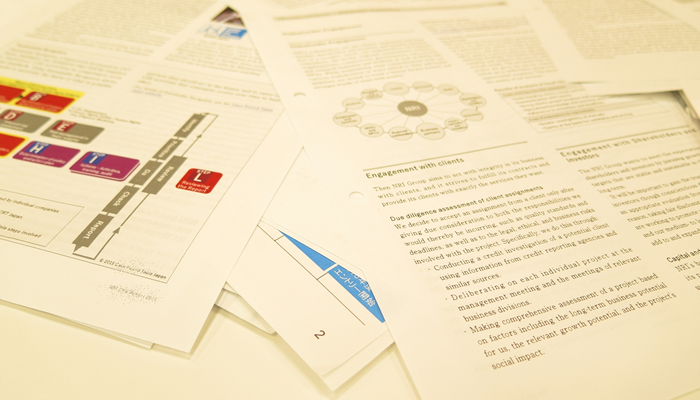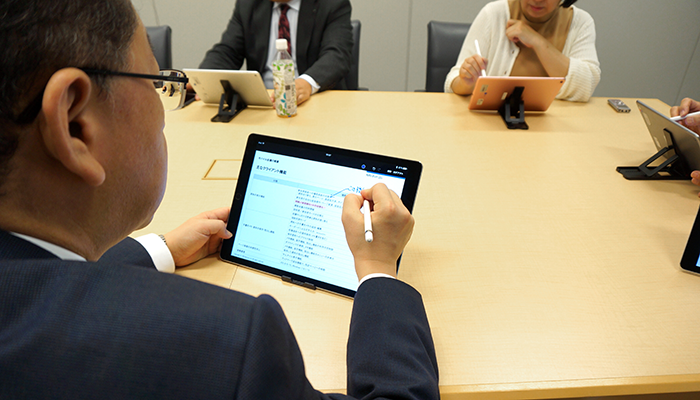
Mobile Technology Contributing to Paperless Meetings
There have been calls for paperless operations in companies, but many companies still distribute a large volume of paper materials for meetings and discussions. NRI Netcom had recognized the problem with using paper, and began providing the Mobile Conference 3 paperless conferencing system for companies in 2010. It has been implemented in over 150 companies, and provides benefits such as reduced paper use and lighter administrative workload.
Paper materials for meetings increase workload and present a risk of information leaks
Although it is normal for each person to have a PC and advances have been made in the digitization of information, paperless operations within companies have not progressed as expected, and offices are overflowing with paper. Reduction of paper used is a major objective for many Japanese companies. From the perspective of reducing environmental impact and lowering costs, companies have continued patient efforts aimed at paperless operations.

Image: Overflowing paper materials
According to the Japan Paper Association's "2016 Paper and Paperboard Domestic Demand Estimate (Actual Figures and Outlook)," domestic demand for information paper (copy paper, inkjet paper, etc.) was 1,839,000 tons in 2013, 1,831,000 tons in 2014, and 1,812,000 tons in 2015. Although a slight decrease was seen, it appears that the efforts of companies have merely resulted in "not increasing paper use."
What is particularly noticeable in the amount of consumption in business settings is paper materials distributed in meetings and discussions. Many government agencies and companies still prepare a large volume of paper materials for management meetings, regular meetings, discussions and briefings, and distribute them to participants. If progress is to be made in paperless operations, it will be necessary to start with making internal meetings paperless. In fact, many companies aiming to significantly reduce internal paper use are making an effort to ensure meetings are paperless.
Mobile Conference 3 created from awareness of problem in own company
The first step was to make internal meetings paperless.
NRI Netcom's Mobile Conference 3 was created as a service for addressing this issue. It has been provided as a new meeting system using tablets since 2010.
Hidemi Takashima of NRI Netcom's Digital Marketing Business Department has been involved in Mobile Conference 3 since the planning phase, and said, "The paper materials distributed in meetings and the related costs had become a problem in our company. In order to limit the consumption of paper, we wanted to find a way to realize paperless meetings. We had a strong desire to achieve this."
In 2010, NRI Netcom held meetings of five or six officers once a week and manager-class meetings with around 40 participants from Tokyo and Osaka twice a week, and an average of 20 pages of paper materials were distributed to each person in every meeting. That amounted to over 1,700 pages being used every week. Annually, this amount exceeded 85,000 pages. "In addition to the amount of paper consumed, much time and work was spent by office staff copying materials the day before such meetings. It was essential that we achieved paperless operations to reduce costs, environmental impact and workload."
Simple operability implemented in over 150 companies
Development began in June 2010, and internal use commenced in July. In late October, sales of Mobile Conference 3 using iPads began in Japan.
Mobile Conference 3 provides a mechanism for multiple participants in meetings to view materials stored on a server using their respective devices. The content on screen changes as the proceedings are moved forward by the chair of the meeting. It is characterized by simple operation and being able to be used by anyone without looking at a manual. Nevertheless, there were some obstacles for implementation in various companies. NRI Netcom worked with customers to examine what the aim of this is now and what the issues are. The results of such efforts and advancements in technology were utilized to repeatedly upgrade the system, and now "Mobile Conference 3 3" supports both iPads and Windows PCs. Because mixed use is also possible, companies do not need to purchase new tablet devices, and this eliminated resistance in terms of cost. Furthermore, the implementation of wireless LAN communication technology such as Wi-Fi has also provided a boost for implementation. At present, it has been implemented in over 150 companies, and is promoting paperless environments in management meetings mainly in large companies.
Tens of thousands of pages of paper materials eliminated
Takashima sees the objectives of companies implementing Mobile Conference 3 to be as follows. "Many customers perceive (i) printing costs, (ii) administrative staff workload and (iii) information security due to loss of paper materials to be problems. They implement our system to resolve these issues, and are feeling the benefits."

Meeting scene: Participants can concentrate on the meeting while looking at materials on screen
One example is NH Foods Ltd., which is one of the companies that has implemented the system. Management meetings with around 25 participants are held eight or nine times every month, and 20 to 50 pages of paper materials were distributed to each participant. The amount of paper consumed each year was about 72,000 pages. This has been significantly reduced with the implementation of "Mobile Conference 3," leading to a reduction in environmental impact. The materials handled in management meetings contained confidential information, so focus was also placed on the quality of security management.
AIRDO Co., Ltd., which implemented Mobile Conference 3 in 2012, had been using over 20,000 pages of paper in major meetings every year. This company also achieved paperless meetings by implementing Mobile Conference 3. Use of paper was reduced to zero, resulting in reduced costs and lower environmental impact.
It will continue to be a tool for promoting paperless offices
Takashima added that in addition to the paperless aspect, the system has had effects that were not expected before implementation. For example, many customers have commented that "meetings have become shorter." Other effects mentioned are improved quality of meetings, more efficient sharing of internal information after meetings are completed, efficient handling of revisions to meeting materials and reduction of business trips.
Mobile Conference 3 was created from awareness of a problem in NRI Netcom. Members of NRI Netcom involved in the service feel that theywould be pleased if they could contribute to a better office environment by reducing the amount of paper resources used and lightening the workload of administrative staff.
In future, the amount of paper consumed in Japanese officers can be significantly reduced if the paper materials distributed in the meetings, discussions, seminars and briefings held in each division of companies are eliminated. NRI Netcom will make efforts aimed at the reduction of environmental impact through paperless operations, in addition to contributing to further stimulation of business activities and the improvement of information security through services such as Mobile Conference 3.